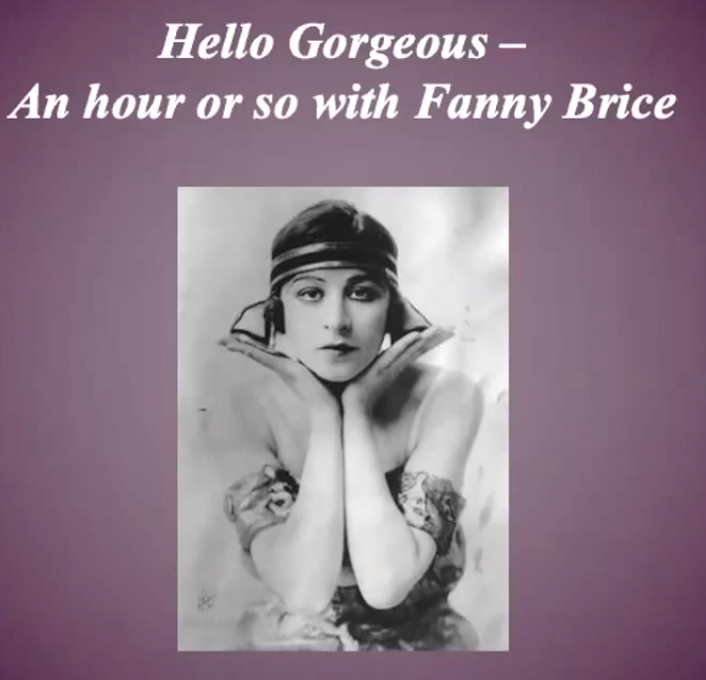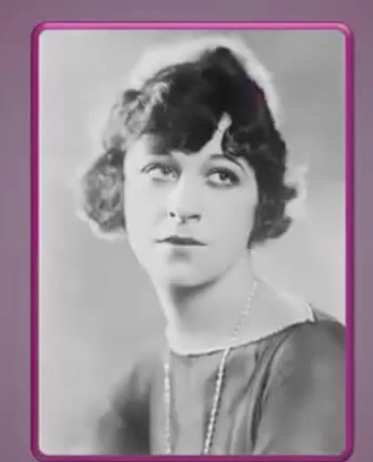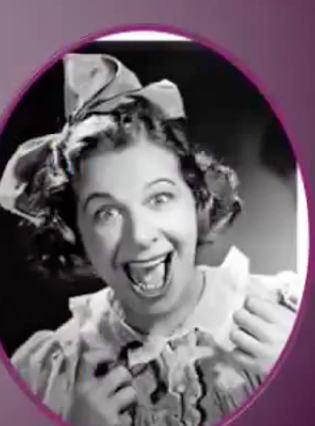Fanny Brice: Bumpy Road to Stardom and a Lesson in Perseverance
By Sue Weston and Susie Rosenbluth – Two Sues on the Aisle
Vaudeville celebrity Fanny Brice, arguably the mother of all American-Jewish comics, was the subject of a Lower East Side Jewish Conservancy (LESJC) Zoom program entitled “Hello Gorgeous: An Hour or So with Fanny Brice—the Consummate Performer.”
The short tour through Ms. Brice’s life—from her early days in the tenements on the Lower East Side through her rise to stardom—was conducted by Dr. Sharon Keller, a professor at Hofstra University whose interests range from literature and art of the ancient Mediterranean world to Hebrew and Judaic studies.
Dr. Keller’s talk on Fanny Brice focused on timeless topics, including new beginnings and the resilience demonstrated by Jews who immigrated to a new country and created undreamed-of prosperity. But in Ms. Brice and her family, especially her mother, Dr. Keller saw a different kind of story, one which took place in an era in which women were provided for, Ms. Brice and her mother were providers. Despite failed marriages, they had successful careers while caring for their families.
Lower East Side
She was born Fania Borach in 1891 on the Lower East Side, where her mother, Rose Stern, settled after arriving from Budapest at the age of ten. At age 18, Ms. Stern married, and Dr. Keller seemed certain it was not for love. She chose Alsatian-Jewish immigrant Charles Borach, a debonair saloon owner/bartender who was known in the neighborhood as Pinochle Charlie. More importantly, he earned $80 a week.
That salary seems to have ended when Mr. Borach retired to play cards, and Rose manages for the family-owned cigar/candy store in Newark. Nevertheless, the couple had four children: Philip (1887), Carrie (1889), Fania, and Louis (1893).
Over the years, Rose moves the family from the Lower East Side to Newark, Camden, and then later to Brooklyn and back to Manhattan, becoming a successful property owner in her own right.
Early Struggles
From all accounts, Fania (called Fanny) was a “big-hearted and mischievous” child whose first crack at performing was when she learned to cry at will to get bus fare or money for snacks.
This skill became her career in 1906 when, unable to afford admittance to a club, she pretended to be an amateur-night contestant. When she was forced onto the stage, she won the contest and continued performing—and winning—amateur competitions in New York until 1907 when she landed a spot in the chorus of George Cohan’s The Talk of New York. She eventually lost the job because she could not dance.
But determined to become a performer, the gangly girl with the strong voice dropped out of school in 1908 after finishing eighth grade and signed up for acting lessons at a school that went bankrupt. She then joined the Eastern Burlesque Circuit, where she learned to dance and, trying to sound less ethnic, also changed her last name to Brice.
Yiddish Persona
Ironically, a year later, Ms. Brice, who spoke almost no Yiddish, made her Broadway debut in a musical, The College Girls, singing Irving Berlin‘s Jewish comedy song, “Sadie Salome, Go Home,” which she sang with a put-on Yiddish accent while dancing a parody of the seductive veil dance in Richard Strauss’ opera Salome.
Her act brought down the house, and despite her desire for universality, Ms. Brice found her niche as a “Jewish” entertainer when she was discovered by Florenz Ziegfeld.
In 1910, she joined the Ziegfeld Follies, adopting the Yiddish accent and mannerisms, which became her signature shtick. In 1916, she hired songwriter Blanche Merrill, who wrote: “Becky’s Back in the Ballet” and “The Yiddish Bride” especially for her.
To be successful on stage, Ms. Brice affected a Yiddish background she really did not possess.
First Marriage
Just as she was portrayed by Barbra Streisand in the 1986 film, Funny Girl (produced by Ms. Brice’s son-in-law, Ray Stark, the husband of her daughter, Frances), Ms. Brice was always impulsive.
In 1910, she married Frank White, who, according to Dr. Keller, was an avid fan and suitor.
“She married Frank in Schenectady a week after they met. They lived together for two days, and then she returned to the tour,” said Dr. Keller, explaining that, in later years, Ms. Brice insisted she had married him because it was a rainy Sunday in Albany, there was nothing to do, and Frank “smelled so nice.”
Nick Arnstein
Her second husband—and the one most recognized because of the portrayal given of him by Omar Sharif in Funny Girl—was Jules Wilford “Nick” Arnstein, a con man with an extensive number of aliases who, by the time Ms. Brice married him, had been in and out of jail.
According to Dr. Keller, she married Mr. Arnstein, who had been married before (and whose first wife, before divorcing him, sued Ms. Brice for “alienation of his affection”), because “he looked so nice.” Dr. Keller suggested it was likely that he reminded Ms. Brice of her father, Charles.
In addition to their daughter, Frances, the couple had a son, William Arnstein, known professionally as William Brice, an American artist famous for his large-scale abstract paintings.
Second-Hand Rose and Billy Rose
The relationship between Ms. Brice and Mr. Arnstein accompanied her rise to fame, and her hit song, which was featured in the Ziegfeld Follies of 1921, “My Man”—about a woman in love with a louse—was written when Arnstein was in prison.
The second song most associated with Ms. Brice is also from the 1921 Follies, “Second-Hand Rose.” In its original version, it has the line, “Even Jakie Cohen he’s the man I adore/He had the nerve to tell me he’s been married before.” In the version sung by Ms. Streisand in Funny Girl, it was changed so that the man in question is “Jake the Plumber.”
In 1929, Ms. Brice married her friend, the songwriter and stage producer, Billy Rose, and appeared in his review, Crazy Quilt. The marriage ended in 1938.
According to Dr. Keller, Ms. Brice married Mr. Rose because she liked the way he thought. Dr. Keller said Ms. Brice described their marriage as a business partnership.
“I was never bored with Billy,” Ms. Brice once reminisced.
Baby Snooks
While she was still married to Mr. Rose, she began wearing a baby costume on stage, playing a little girl the writers called Baby Snooks. Ms. Brice insisted she started doing Snooks as early as 1912 when she played a child on the vaudeville stage.
Eventually, the loveable, precocious, bratty toddler who was always getting into trouble especially with her jokes was seen not only on stage, but also in the movies and especially on radio, where, as featured players on variety shows, she, her little brother, and their parents turned minor accidents into full-scale disasters.
In 1944, Ms. Brice was given her own radio show, The Baby Snooks Program. She presented the character once on television, in 1950, as part of CBS-TV’s Popsicle Parade of Stars.
Message of Strength
The picture Dr. Keller drew of Ms. Brice and her mother was of women driven to succeed. “If you have a career, then the career is your life,” Ms. Brice is reported to have said.
She and her mother raised children on their own while simultaneously chasing dreams and going from one endeavor to another without a backward glance.
Each balanced—sometimes successfully, other times not—families, careers, and adventures, recreating themselves when necessary, and stepping up to face challenges.
When Ms. Brice suffered a serious heart attack and died of a stroke in 1951, she knew a lot about strength and tenacity, traits that serve women today in the 21st century as much as they did at the turn of the 20th.
***
Two Sues on the Aisle bases its ratings on how many challahs it pays to buy (rather than make) in order to see the play, show, film, or exhibit being reviewed. 5 Challahs is our highest rating.
“Hello Gorgeous: An Hour or So with Fanny Brice—the Consummate Performer” received 5 challahs.









